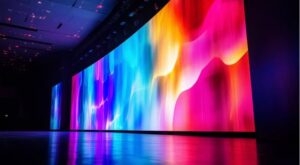Vertical Market - Virtual Production
Virtual Production (VP) is revolutionizing the film, television, and content creation industries by blending physical and digital environments in real-time. At the heart of this innovation are LED display technologies, which are transforming traditional production workflows and enabling Extended Reality (XR) environments that immerse both creators and audiences like never before. By using high-performance LED video walls as dynamic digital backdrops, virtual production teams can create photorealistic environments in-camera, reducing the need for green screens, location shoots, and extensive post-production work.
One of the most significant advantages of LED displays in VP is their ability to render real-time, interactive 3D environments using powerful game engines like Unreal Engine. These environments are displayed on large-format, curved or dome-shaped LED walls, wrapping around the set to create a seamless visual horizon. Actors perform in front of these high-resolution displays, with live camera tracking ensuring the perspective shifts accurately with the camera’s movement. This allows for in-camera visual effects (ICVFX)—capturing final or near-final footage during the shoot, eliminating the need for green screen keying and lengthy compositing.
The visual quality of LED displays is critical to achieving realism. Fine pixel pitch panels provide the resolution necessary to display detailed textures, accurate lighting, and deep color depth without visible pixelation, even when viewed up close or through a camera lens. High brightness, contrast ratios, and refresh rates ensure smooth, flicker-free visuals that can accurately simulate sunlight, reflections, and atmospheric conditions, allowing for complex lighting interactions between the actors and the virtual set. This realism helps both the talent and production crew stay immersed in the scene and make creative decisions more effectively.
LED displays also streamline production timelines and budgets. With LED stages, there’s significantly less need to travel to remote or exotic locations. Directors can shoot multiple “locations” in a single day, all from within a controlled studio environment. This not only reduces logistical costs and environmental impact but also offers greater creative flexibility—allowing directors to iterate and fine-tune environments in real time. Weather and time-of-day constraints are also eliminated, giving productions full control over every visual element of the scene.
In Extended Reality (XR) applications such as broadcast production, live events, and corporate presentations, LED displays are used to create immersive virtual stages where talent interacts naturally with digital environments. LED floors, ceilings, and side walls envelop presenters in dynamic visuals that react in real time. Whether it’s a sports analyst standing in a 3D-rendered stadium or a CEO delivering a keynote from a futuristic virtual environment, LED-based XR stages add visual impact and realism that traditional green screen setups cannot match.
Moreover, LED stages are highly modular and scalable, allowing studios to build virtual production volumes of any size or shape—from small-scale VP setups for indie creators to massive soundstage installations for major film and streaming studios.
In summary, LED display technology is driving the future of virtual production, empowering storytellers to craft immersive, real-time experiences while cutting costs, accelerating timelines, and expanding creative horizons. As VP and XR continue to evolve, LED displays will remain the visual foundation that brings digital worlds to life.



